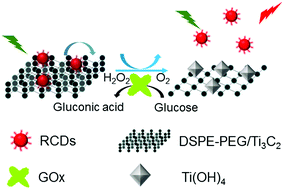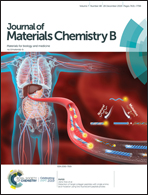Titanium carbide MXenes combined with red-emitting carbon dots as a unique turn-on fluorescent nanosensor for label-free determination of glucose†
Abstract
Titanium carbides (Ti3C2), a new family of two-dimensional (2D) nanomaterials, have attracted extensive attention due to their unique structure and desirable physiochemical properties. Herein, we developed an effective and selective fluorescent turn-on nanosensor for glucose detection based on Ti3C2 nanosheets combined with red-emitting carbon dots (RCDs). The fluorescence intensity of RCDs could be effectively quenched (>96%) by Ti3C2 nanosheets through the inner-filter effect (IFE). In the presence of H2O2, the quenched fluorescence of the RCDs can remarkably recover due to the Ti3C2 nanosheets which were oxidized into Ti(OH)4 by H2O2. Based on H2O2 generated from oxidation of glucose catalyzed by glucose oxidase, the nanosensor can also be exploited for monitoring glucose. Under optimal conditions, a linear relationship between the increased fluorescence intensity of RCDs and the concentration of glucose was established in the range from 0.1 to 20 mM. The detection limit was 50 μM (S/N = 3). The proposed nanosensor also represented excellent selectivity for glucose analysis in biological fluid samples, providing a valuable platform for glucose sensing in clinical diagnostics.



 Please wait while we load your content...
Please wait while we load your content...